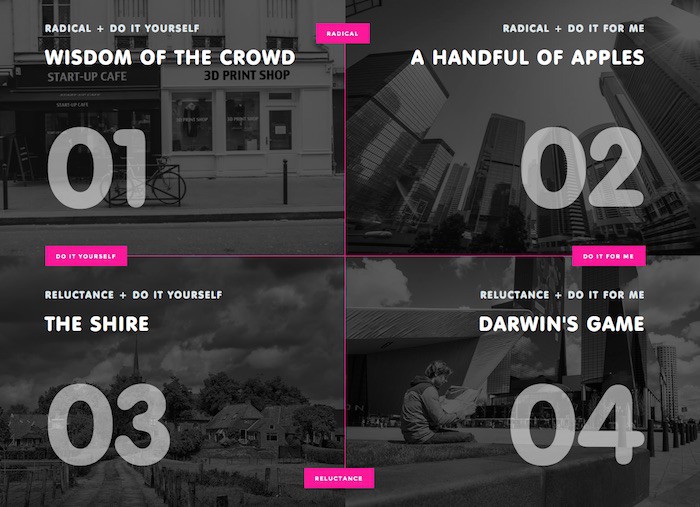
The future of journalism will come down in one of four ways. At least, that’s what a new report What’s New(s): Scenarios for the Future of Journalism, released by the Dutch Journalism Fund this week purports. And while the study looks specifically at the future of media in the Netherlands, the visions they describe are easily transferable to wherever you live.
The study comes as Dutch news outlets are facing a reckoning. Many of its largest media companies, including NRC, Mediagroep Limburg, and Wegener, have been sold, and the country’s daily newspapers are going through a period of declining subscription numbers and contracting staffs. But the Netherlands has also been home to an unusually high number of startups and new projects, including Blendle, De Correspondent, NRC Q, and Dichtbij.
The report, which will be presented to the Dutch parliament, identifies four possible futures for 2025. There’s “The Wisdom of the Crowd,” a world where journalistic startups have crushed traditional industry and the sharing economy prevails. Journalistic enterprises are bootstrapped and rely on crowdfunding, while a healthy skepticism by the public of major media interlopers like Apple and Facebook is maintained.
By contrast, there’s “A Handful of Apples,” where giant technology companies — see the aforementioned Apple and Facebook — have set the agenda. News is highly personalized, but that’s due to the fact that all the chains and distribution platforms have been tightly contracted into the webs of these huge new powers. In this dystopian future, the traditional news industry has not survived and is now ruled by tech.
For the locally minded or tech-averse, the future promised by “The Shire” will seem appealing. Though traditional institutions have still not survived in this scenario, they’ve been replaced by local and regional publications that are civically inclined. On thematically driven community sites, both citizen journalists and professional reporters find an audience. Finally, the fourth vision, “Darwin’s Game,” is well, darwinian — media organizations must adapt or perish. The narrowing mechanism is, rather unexpectedly, transparency. In “Darwin’s Game,” the news-consuming public has come to have exacting standards for the quality of their journalism, and wants journalists to show their work. To survive in this world, traditional media should expect to evolve in how they see their audience. Those that don’t should not expect to survive.
To go about defining these scenarios, the Dutch Journalism Fund took an unorthodox approach. Using a method pioneered by energy-company Shell, the fund gathered 150 journalists, editors, freelancers, businessmen, scientists, and technologists for a series of conferences, meetings, and interviews. Over the course of the meetings, stakeholders whittled down big picture questions to 70 or so themes of concern to the journalism industry, which they then decided were “certain” or “uncertain” to continue.
This eventually broke down to two key uncertainties — are news readers looking for radical or reluctant change, and how accepting of technology will we be in the future. The possibilities: reluctant vs. radical, and do-it-yourself, vs. do-it-for me, are meant to reflect the tensions at work in the world of Dutch journalism.
The combination of the two critical uncertainties creates four fictitious worlds in 2025, located at extreme points of the matrix. These worlds reflect the current hopes and fears of Dutch journalism, in particular the tension between professional and public journalism, the uncertain future of Dutch media corporations and titles, the role of hardware and software in the production and dissemination of news, and the way in which quality journalism will be funded in 2025.
As for which scenario is most likely, the report’s authors believe all are equally plausible at this point. Consider this your notice.